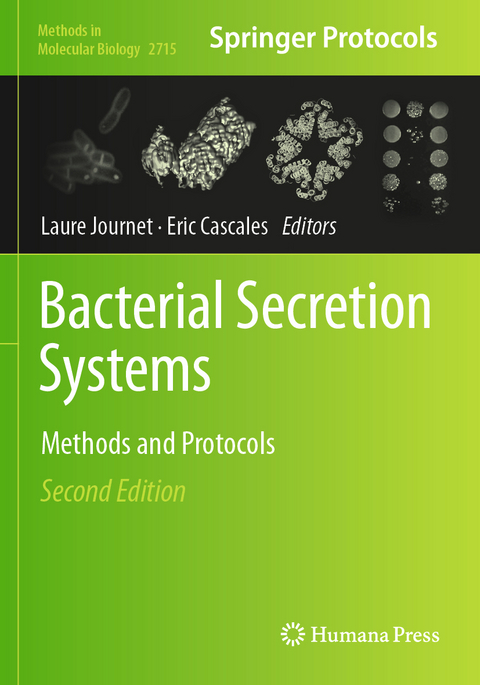
Bacterial Secretion Systems
Springer-Verlag New York Inc.
978-1-0716-3447-9 (ISBN)
Authoritative and cutting-edge, Bacterial Secretion Systems: Methods and Protocols- Second Edition aims to be a useful andpractical guide to new researchers and experts looking to expand their knowledge.
Identification of protein secretion systems in bacterial genomes using MacSyFinder version 2.- Protein sorting prediction.- Cell fractionation.- Components sub-cellular localization: identification of lipoproteins using globomycin and radioactive palmitate.- Components sub-cellular localization: identification of lipoproteins using alkyne fatty acids and click-chemistry.- Defining membrane protein localization by isopycnic density gradients.- Components sub-cellular localization: Cell surface exposure.- Probing protein topology and conformation by limited proteolysis.-Exploring uniform, dual and dynamic topologies of membrane proteins by substituted cysteine accessibility method (SCAMTM).- Preparation of uniformly oriented inverted inner (cytoplasmic) membrane vesicles from Gram-negative bacterial cells.- Defining membrane protein topology using pho-lac reporter fusions.- Measure of peptidoglycan degradation activity.- Protein-protein interaction: Bacterial Two-Hybrid.- Protein-protein interactions: oxidative Bacterial Two-Hybrid.- Protein-protein interactions: Yeast two-hybrid.- Protein-protein interactions: Bimolecular Fluorescence Complementation and Cytology two-hybrid.- Bacterial one- and two-hybrid assays to monitor transmembrane helix interactions.- Protein-protein interactions: Co-immunoprecipitation.- Protein-protein interaction: Tandem Affinity Purification in bacteria.- In vivo site-directed and time-resolved photocrosslinking of envelope proteins.- Identification of protein partners by APEX2 proximity labeling.- Blue native PAGE analysis of bacterial secretion complexes.- Surface Plasmon Resonance: a sensitive tool to study protein-protein interactions.- Defining assembly pathways by fluorescence microscopy.- Large complexes: cloning strategy, production and purification.- Starting with an integral membrane protein project for structural biology: production, purification, detergent quantification and buffer optimization - case study of the exporter CntI from Pseudomonas aeruginosa.- Structural analysis of protein complexes by cryo electron microscopy.- CryoEM data analysis of membrane proteins. Practical considerations on amphipathic belts, ligands and variability analysis.- Structural analyses of bacterial effectors by X-ray crystallography.- Structural analysis of proteins from bacterial secretion systems and their assemblies by NMR spectroscopy.- Quantifying substrate protein secretion via the type-III secretion system of the bacterial flagellum.- Use of Bastion for the identification of secreted substrates.- Identification of effectors: Precipitation of supernatant material.- Metabolic labelling: snapshot of the effect oftoxins on the key cellular processes.- Effector translocation assay: differential solubilization.- Monitoring effector translocation with the TEM-1 beta-lactamase reporter system: from endpoint to time course analysis.- Quantitative determination of anti-bacterial activity during bacterial co-culture.- Investigating secretion systems and effectors on Galleria mellonella.
| Erscheinungsdatum | 22.11.2024 |
|---|---|
| Reihe/Serie | Methods in Molecular Biology |
| Zusatzinfo | 97 Illustrations, color; 23 Illustrations, black and white; XVI, 613 p. 120 illus., 97 illus. in color. |
| Verlagsort | New York, NY |
| Sprache | englisch |
| Maße | 178 x 254 mm |
| Themenwelt | Naturwissenschaften ► Biologie ► Mikrobiologie / Immunologie |
| Schlagworte | Cell fractionation • Fluorescence Microscopy • Isopycnic Density Gradients • Lipoprotein Localisation • Proteolysis |
| ISBN-10 | 1-0716-3447-X / 107163447X |
| ISBN-13 | 978-1-0716-3447-9 / 9781071634479 |
| Zustand | Neuware |
| Informationen gemäß Produktsicherheitsverordnung (GPSR) | |
| Haben Sie eine Frage zum Produkt? |
aus dem Bereich


